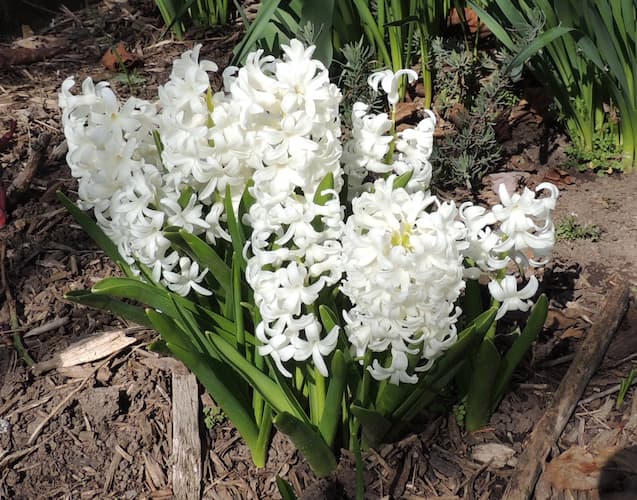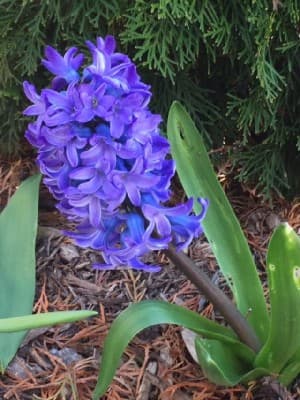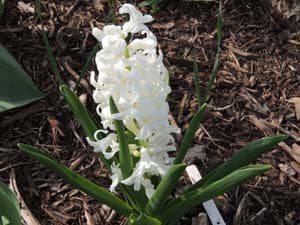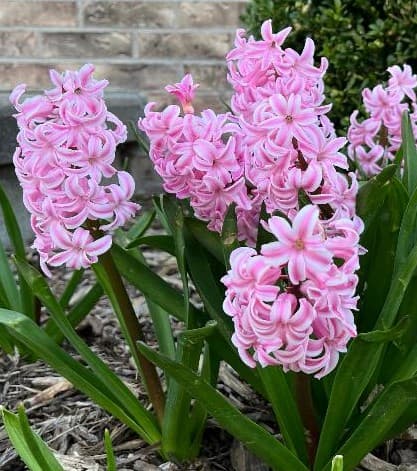How to Grow Hyacinth Flower Bulbs

About Growing Hyacinth Flower Bulbs in Your Home Garden
A member of the Lilly family, bright and bold Hyacinth bulbs are quite the travelers. We commonly think of Hyacinth flowers as Dutch Bulbs, and therefore, originating in the Netherlands. But, they originated in Turkey. During the 1500s, traders brought them back to Europe and they found a perfect home in the soil and climate of the Netherlands. Later, they were introduced into the United States and quickly gained popularity. Now, you find Hyacinth growing and blooming just about anywhere.
Hyacinths are a beautiful and fragrant spring-flowering bulbs. There are three species and hundreds of varieties. There are early, mid, and late spring blooming varieties. Gardeners and homeowners love the sweet fragrance that lingers in the Spring air, and the breadth of bright beautiful flower colors. And they are resistant to deer, rabbits, squirrels, chipmunks, and other animal pests. So, they are the perfect plants to grow in areas where these pests are present.
They are also popular as a forced bloom in winter, brightening your home or office. Keep active in gardening during the cold, snowy months by forcing your own. Why should greenhouses have all the fun!?! Forcing Hyacinth Bulbs
Did You Know? Hyacinths are a distant relationship to the Asparagus family.

Hyacinth Flowers Plant Specifications
Flower Colors: Varying shades of apricot, blue, cream, pink, purple, red, violet, and white.
Flowers Bloom: Early, mid, and late spring varieties.
Plant Height: Grows up to six to twelve inches tall, and three to six inches wide, depending upon variety.
Light Requirements: Full sun to partial dappled shade.
Ideal Soil pH: 6.5 – 7.5.
Toxic?: Toxic to humans and pets.
Deer Resistant?: Yes. It is resistant to other pests, too.
Hardiness Zones: 3 – 9
Plant Type: Perennial
Native To: Turkey, Mediterranean, and tropical Africa.
Botanical Name: Hyacinthus orientalis
Other Names: Common hyacinth, Dutch hyacinth, garden hyacinth
Are Hyacinth Plants Edible?
No!!! However, the flowers are edible.
Hyacinth plants and bulbs are mildly toxic to humans, pets, and many other animals.
The bulbs and plants have oxalic acid. If ingested, this chemical causes an upset stomach. And, it is a skin irritant.
Medicinal Uses for Hyacinth Plants and Bulbs
We are not aware of any medicinal applications for this mildly toxic plant and bulb.
Use caution when researching the internet for medicinal information about this plant. A search will lead you to other plants that include the name “Hyacinth. Some examples are grape hyacinth and Hyacinth bean plants.
Light Requirements
Hyacinth plants grow well in full sun to partial shade. They perform their best in six to eight hours of direct sunlight. Homeowners often plant them under shade trees as these spring bloomers grow and bloom in the spring before the foliage emerges to a point where it shades the plant too much. This often works well for early and mid-spring blooming varieties. However, the late-blooming varieties can be negatively impacted by too much shade from fast-emerging spring foliage.
Hyacinth Bulbs Propagation
Hyacinth plants are grown from bulbs. Select quality bulbs, that have not dried out. The larger the bulb, the bigger the plant and flower next spring.
Every year the “mother” bulb that you originally planted, will produce baby bulbs. The babies grow below and to the side of the mother bulb. After a few years, the plants become overcrowded. They need to be dug up and replanted. After the plants have died back for the year, dig up the bulbs Then, separate and replant them.
And, make sure to save a few Hyacinth bulbs to force indoors in the winter months. They will brighten up your home with their beautiful and fragrant blooms. Forcing Hyacinth Bulbs
Garden Tip: Grow early, middle, and late-blooming varieties. As a result, you’ll enjoy these fragrant bloomers all spring long.

How to Grow Hyacinth Flowers
Growing Hyacinth plants is fun and easy. With just a little care, your bulbs will bloom into beautiful, fragrant flowers in early to mid-spring.
Plants the bulbs in the fall. Plant about two to four weeks before the ground freezes, to allow the roots to develop underground. Plant them 6-8 inches deep. Space plants six inches apart. Plant in groups for an artistic effect. But, don’t overcrowd them.
Sprinkle a little bulb fertilizer in the hole during planting. For established beds, spread the fertilizer on top of the soil. You can work it in lightly, but you risk damaging the bulbs.
Hyacinths will grow well in shade to full sun but do best in bright sunlight. We recommend staking the flower stems to avoid them bending or breaking in strong spring breezes.
After they bloom in the spring, allow the plants to grow until the leaves die off. They need time after blooming to store energy in the bulbs for next year. To remove the dead plant, either snip them off at the base or twist the leaves while pulling lightly. Now, the bulbs will sleep until next spring.
Do not disturb the area where the bulbs are planted. An errant shovel pushed into the ground, risks damaging the sleeping Hyacinth bulbs.

Do Hyacinth Plants Need Pruning?
Growing this practically no-maintenance spring bloomer requires no pruning. That means you get to enjoy these beautiful and fragrant flowers without any effort at all!
So, we recommend you go outside, breath in the sweetly scented air, and enjoy its beauty while it lasts.
Insects and Plant Disease
Hyacinth flowers have few insect or pest problems.
The bulbs are not on the menu of deer, rabbits, or squirrels.
Plant Problems – Identify the causes and find the cures.
Overwintering Hyacinth Bulb Plants
After the bloom has died, Leave the plane alone. At this time, it is sending energy to the bulb for next year’s growth and blooms. When the plant dies off naturally, cut it down to ground level. The bulb is now resting and will bloom again next spring.
Related Articles
Also, people who read this article will like:
Deer Resistant Flowers – If you’ve got deer, plant flowers the deer do not like.
Hyacinth Picture Gallery – Free to use hyacinth pictures. High Resolution.
Please support our site. Shop for:
- rmmatthews100@hotmail.com
- 585-721-6528
- Rochester, NY
©1999-2024 GardenersNet.Com, All Rights Reserved

